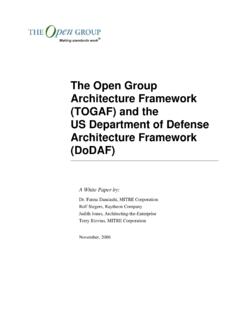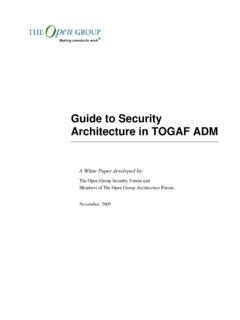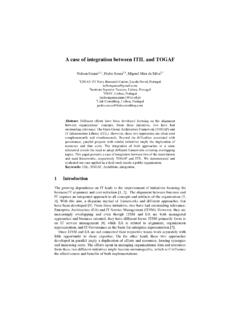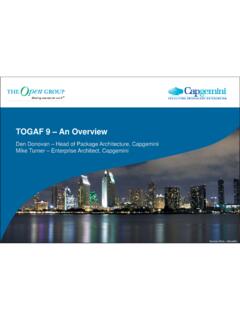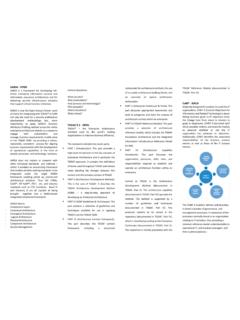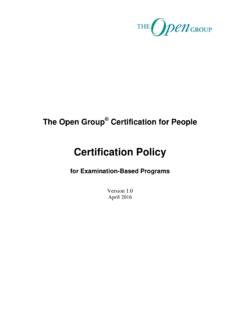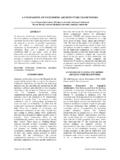Transcription of Enterprise Architecture Overview - Bespoke Systems
1 Enterprise ArchitectureAn OverviewAbout Me G. Hussain Chinoy, Architect In software industry for 18 years Developer, consultancy owner, architect Relevant Formal Training togaf 8 Certified, togaf 9 Trained Agile Scrum Master PM Cert from CSU Software Engineering Cert from CU Huge nerd During the 1980 s, I became convinced that Architecture , whatever that was, was the thing that bridged strategy and its implementation. John ZachmanArchitectureEnterprise Architecture : an Overview What is EA? Why is EA useful? EA FrameworksEA: An Overview What is EA? Intro Why EA?
2 EA FrameworksWhat is EA? Lots of DefinitionsHolistic view of the enterprises IT resources rather than an application-by-application view -Kaisler, et al. 2005EA is a strategic information asset base -defines mission, information necessary to perform the mission, transitional processes for implementing new technologies; includes a baseline and target Architecture and sequencing plan -CIO Council 2001EA provides explicit, common, and meaningful structural frame of reference that allows an understanding of what an Enterprise does, when, where, how, and why it doesitand what it uses to do it -GAO 2003 The design of business and IT system alignment is the domain of EA.
3 EA's seek to align Enterprise processes and structure with supporting IT Systems -Wegmannet al. 2005 What is EA?[EA is] a planning framework that describes how the technology assets of an organization connect and operate. It also describes what the organization needs from the technology. And finally, it describes the set of activities required to meet the organizational it operates in a context of a process for setting priorities, making decisions, informing those decisions, and delivering results called -IT Cureton, CIO NASA How to Rule the World of IT through Enterprise Architecture is EA?
4 You cannot cost justify Architecture . Architecture is not an expense. Architecture does not displace any other costs. Architecture is an asset. You can save orders of magnitude more money and time, but you have to invest in Architecture to enable you to do something you otherwise are unable to do, namely: Alignment, Integration, Change, and Mass Customization. Architecture is an Information-Age idea. Cost Justification was an Industrial Age Zachman2001 What is EA? Identifies the main components of the organization, its information Systems , the ways in which the components work together to achieve defined business objectives, and the way in which information Systems support business processes of the organization Components -staff, business processes, technology, information, financial and other resources Processes.
5 Tools and structures necessary to implement an Enterprise -wide coherent and consistent IT Architecture for supporting the Enterprise 's business operations EA is the process of translating business vision and strategy into effective Enterprise change by creating, communicating and improving the key principles and models that describe the Enterprise 's future state and enable its evolution -Gartner 2006 EA -four types of Architecture subsets ( togaf 2003) business Architecture -strategy, governance, organization, key business processes data/info Architecture -structure of org'slogical/physical data assets and data management resources applications/ Systems Architecture -blueprints for individual applications to be deployed, interactions and relationships to core business processes of the org technology Architecture -software infrastructure intended to support the deployment of mission-critical applications Architecture !
6 = technologyWhat is EA? Business-focused, business-driven approach to architectures A process by which businesses can direct the development of the Enterprise as a whole and, in particular, their IT portfolio. A set of principles that constrain the design space for developers and operations Establish Communicate ApplyArchitecture Principles Business Principles Primacy of Principles Maximize Benefit to the Enterprise Information Management is Everybody s Business Business Continuity Common Use Applications Service Orientation Compliance with Law Data Principles Data is an Asset Data is Shared Data is Accessible Common Vocabulary and Definitions Application Principles Technology Independence Ease-of-Use Technology Principles Requirements-Based Change Responsive
7 Change Management Control Technical Diversity InteroperabilityPrimacy of Principles These principles of information management apply to all organizations within the organizations Rationale The only way we can provide a consistent and measureable level of quality information to decision-makers is if all organizations abide by these principles Implications Without this principle, exclusions, favoritism, and inconsistency would rapidly undermine the management of information Information management initiatives will not begin until they are examined for compliance with the principles A conflict with a principle will be resolved by changing the framework of the initiativeResponsive Change Management Changes to the Enterprise information environment are implemented in a timely manner Rationale If people are to be expected to work within the Enterprise information environment.
8 That environment must be responsive to their needs Implications We have to develop processes for managing and implementing change that do not create delays. A user who feels a need for change will need to connect with a business expert to facilitate explanation and implementation of that need. If we are going to make changes, we must keep the architectures updated. Adopting this principle might require additional resources. This will conflict with other principles ( , maximum Enterprise -wide benefit, Enterprise -wide applications, etc.).Technology Independence Applications are independent of specific technology choices and therefore can operate on a variety of technology platforms.
9 Rationale Independence of applications from the underlying technology allows applications to be developed, upgraded, and operated in the most cost effective and timely way. Otherwise technology, which is subject to continual obsolescence and vendor dependence, becomes the driver rather than the user requirements themselves. Realizing that every decision made with respect to IT makes us dependent on that technology, the intent of this principle is to ensure that Application Software is not dependent on specific hardware and operating Systems software. Implications: This principle will require standards which support portability.
10 For Commercial Off-The-Shelf (COTS) and Government Off-The-Shelf (GOTS) applications, there may be limited current choices, as many of these applications are technology and platform dependent. Subsystem interfaces will need to be developed to enable legacy applications to interoperate with applications and operating environments developed under the Enterprise Architecture . Middleware should be used to decouple applications from specific software : An Overview What is EA? Why is EA Useful? Why (and how) is EA Useful? Why EA? EA Drivers Business Rationale EA FrameworksWhy EA?

